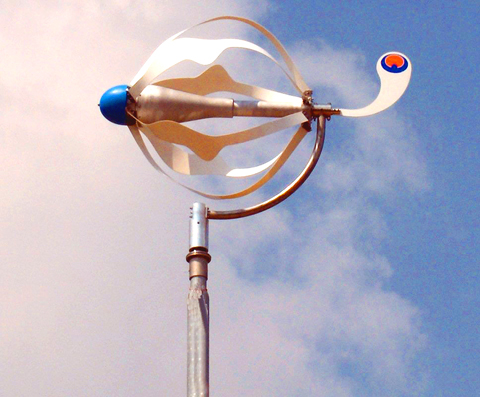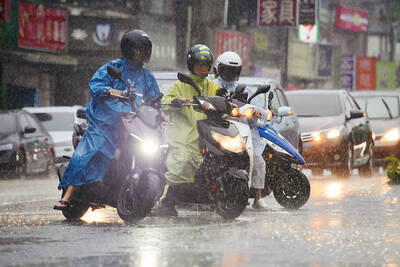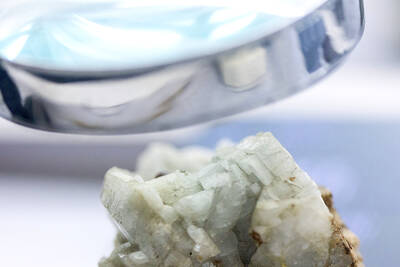Wind turbines typically spin from tall towers on hills and plains. But in these green times, some companies hope smaller turbines will soon rise above a more domestic spot: homes and garages.
The rooftop turbines send the electricity they generate straight on to the home’s circuit box. Then owners in a suitably wind-swept location can watch the needle on their electricity meter turn backward instead of forward, reducing their utility bills while using a renewable resource.
One new model, the Swift Wind Turbine, is designed to do its job quietly, said Dave Anderson, co-director of Renewable Devices in Edinburgh, which has partnered with Cascade Engineering in Grand Rapids, Michigan, to offer the turbine in the US.

PHOTO: NY TIMES NEWS SERVICE
“The noisiest it gets is 35 decibels,” roughly the sound of a quiet conversation, he said of the whir of the blades.
The turbine, which looks like a large wagon wheel, has a ring around its blades designed to diffuse noise and limit vibration.
“The air is steered toward the diffuser ring and dispersed, rather than leaving the blades with a ripping noise,” Anderson said.
The turbine costs US$10,000 to US$12,000 including installation, said Michael Ford, manager of the renewable energy business unit at Cascade Engineering. When the wind is blowing briskly at 48kph or more, it will generate 1.5 kilowatts of electrical power, he said. Enough, for instance, to run fifteen 100-watt light bulbs.
“You need a strong average wind speed,” he said, recommending that prospective customers make careful measurements before they buy.
“Don’t trust your memories about the wind power around your house,” he said. “People always remember when it’s windy,” but forget about the lulls.
Residents may measure wind speed with an anemometer, often available for rent, as well as by entering their address at the Swift Web site, which has listings of average wind speeds for localities.
The Swift turbine starts contributing electricity when the wind blows at 12kph; as the wind speed increases, so does turbine output, Ford said. Over a year, the energy output in windy locations should be roughly 2,000 kilowatt hours, he said, so that for homes that use 11,000 kilowatt hours in a year, for instance, electricity costs would be reduced by about 18 percent.
Kenneth Benefiel of Conklin, Michigan, bought a Swift turbine last fall, and had it installed on his 150-year-old post-and-beam barn, which serves as a garage and workroom, in time for Christmas.
“I had already switched to energy efficient appliances,” he said, reducing electricity usage by a third by buying a more efficient freezer and refrigerator and changing to fluorescent light bulbs. “The turbine was the next step.”
Benefiel, a retired carpenter, said that in the first five weeks after its installation, the turbine produced about 60 kilowatt hours of electricity, enough to power his house for about three days. The machine is quiet, but the old building on which it is mounted does its share of groaning in a stiff wind, he said.
So far, he is satisfied with his purchase.
“The turbine will conserve energy,” he said. “It’s making us more self-sufficient, and we’re doing our part to cut consumption. You have to think not only about saving money, but about saving resources.”
Turbines must be placed well above the roof to benefit from wind energy, said Sander Mertens in Voorburg, the Netherlands, who is a consultant in wind energy and author of Wind Energy in the Built Environment.
For a two-story building, for instance, the turbine should be at least 4.5m above the roof.
“Put it lower, and you will suffer from small wind speeds and a lot of turbulence,” he said.
Mertens offers a spreadsheet at his Internet site, www.ingreenious.com, that can be downloaded by people who want to do their own calculations for optimum turbine placement.
The American Wind Energy Association, a trade group in Washington, recommends placing the turbine at least 9m above anything in a 150m radius, said Ron Stimmel, a specialist in small wind turbines at the trade group American Wind Energy Association, in Washington.
Another small wind turbine for residences is the Energy Ball, to be sold in the US by Home Energy Americas, in McKinney, Texas. Robert Thompson, its chief executive, said he hoped to have the turbines on the market shortly. The Energy Ball is shaped like an eggbeater placed sideways, so that its blades turn around a horizontal axis. One model, the V100, will provide a maximum of 500 watts.

The combined effect of the monsoon, the outer rim of Typhoon Fengshen and a low-pressure system is expected to bring significant rainfall this week to various parts of the nation, the Central Weather Administration (CWA) said. The heaviest rain is expected to occur today and tomorrow, with torrential rain expected in Keelung’s north coast, Yilan and the mountainous regions of Taipei and New Taipei City, the CWA said. Rivers could rise rapidly, and residents should stay away from riverbanks and avoid going to the mountains or engaging in water activities, it said. Scattered showers are expected today in central and

People can preregister to receive their NT$10,000 (US$325) cash distributed from the central government on Nov. 5 after President William Lai (賴清德) yesterday signed the Special Budget for Strengthening Economic, Social and National Security Resilience, the Executive Yuan told a news conference last night. The special budget, passed by the Legislative Yuan on Friday last week with a cash handout budget of NT$236 billion, was officially submitted to the Executive Yuan and the Presidential Office yesterday afternoon. People can register through the official Web site at https://10000.gov.tw to have the funds deposited into their bank accounts, withdraw the funds at automated teller

COOPERATION: Taiwan is aligning closely with US strategic objectives on various matters, including China’s rare earths restrictions, the Ministry of Foreign Affairs said Taiwan could deal with China’s tightened export controls on rare earth metals by turning to “urban mining,” a researcher said yesterday. Rare earth metals, which are used in semiconductors and other electronic components, could be recovered from industrial or electronic waste to reduce reliance on imports, National Cheng Kung University Department of Resources Engineering professor Lee Cheng-han (李政翰) said. Despite their name, rare earth elements are not actually rare — their abundance in the Earth’s crust is relatively high, but they are dispersed, making extraction and refining energy-intensive and environmentally damaging, he said, adding that many countries have opted to

PEACE AND STABILITY: Maintaining the cross-strait ‘status quo’ has long been the government’s position, the Ministry of Foreign Affairs said Taiwan is committed to maintaining the cross-strait “status quo” and seeks no escalation of tensions, the Ministry of Foreign Affairs (MOFA) said yesterday, rebutting a Time magazine opinion piece that described President William Lai (賴清德) as a “reckless leader.” The article, titled “The US Must Beware of Taiwan’s Reckless Leader,” was written by Lyle Goldstein, director of the Asia Program at the Washington-based Defense Priorities think tank. Goldstein wrote that Taiwan is “the world’s most dangerous flashpoint” amid ongoing conflicts in the Middle East and Russia’s invasion of Ukraine. He said that the situation in the Taiwan Strait has become less stable